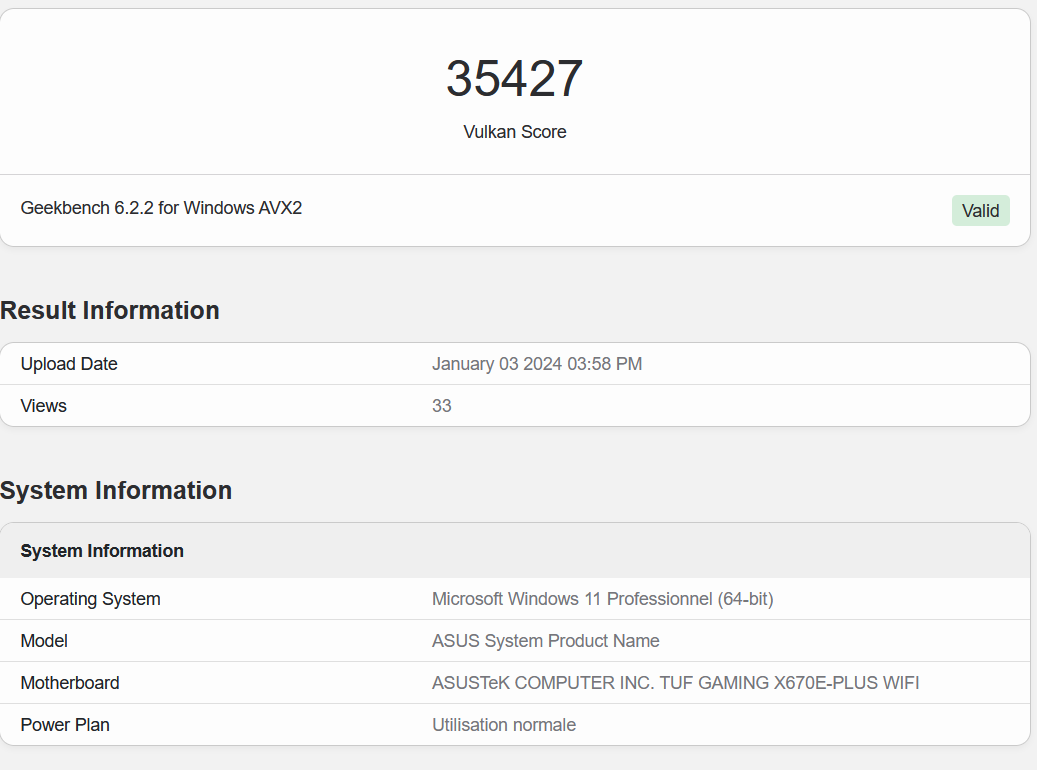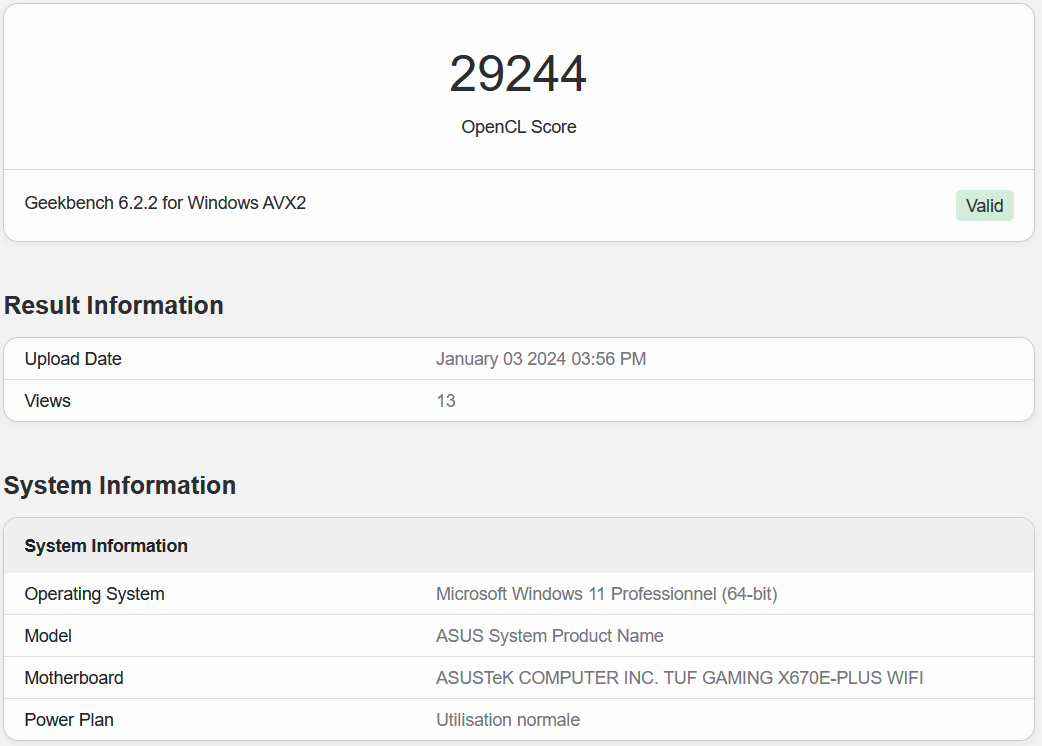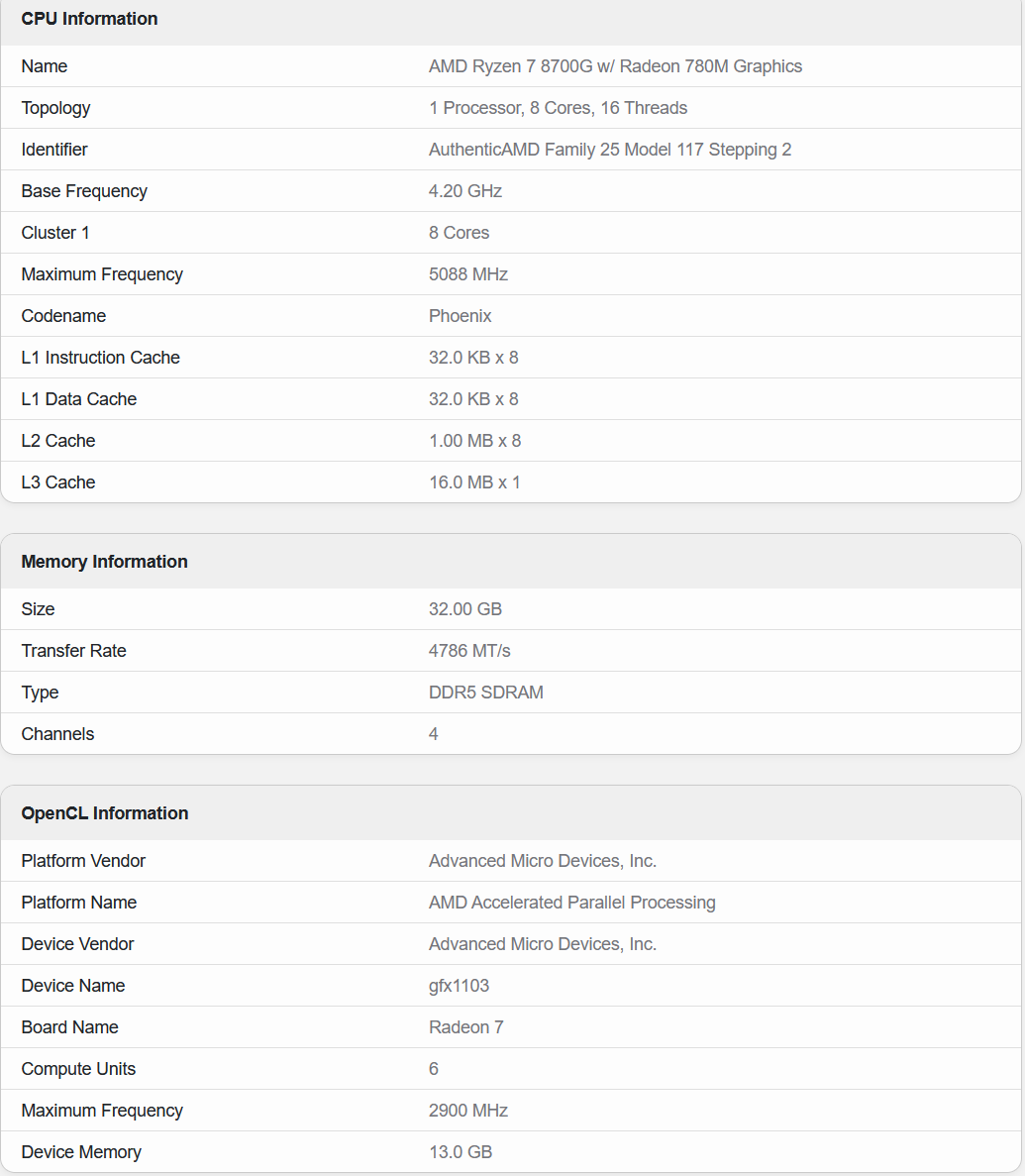AMD's Radeon 780M integrated graphics get close to GTX 1650 in Geekbench 6 — Ryzen 7 8700G iGPU benchmark leaked

Benchleaks (on X) has unveiled set of Geekbench 6 Vulkan and OpenCL benchmarks showing the performance of AMD's upcoming Ryzen 7 8700G featuring AMD's flagship RDNA 3 iGPU, the Radeon 780M. The 8700G outperformed its mid-range counterpart, the 8600G (whose Geekbench 6 results leaked yesterday), with results approaching those of Nvidia's GTX 1650.
The 8700G scored 35,427 points in Geekbench 6.2.2's Vulkan benchmark and 29,244 points in the OpenCL benchmark. That's 13% higher than the 8600G in the Vulkan benchmark and 15% higher in the OpenCL benchmark. The 8700G's score was significantly higher than some of Nvidia's older discrete GPUs, such as the GTX 1060 and the GTX 1630. The GTX 1060's score in the Vulkan benchmark was 17% lower than the 8700G's score, and the GTX 1630's Vulkan score was a whopping 49% lower. The 8700G's score is so high that it's within 5% of the score of Nvidia's GTX 1650 in Geekbench 6.
The 8700G's powerful integrated graphics did lose to some mobile Radeon 780M results in Geekbench 6, however. The Radeon 780M we used for the 8600G report actually outperformed the 8700G's OpenCL benchmark by 3.3% (but the 8700G did beat the 780M's Vulkan benchmark by 5%).



| Model | Vulkan | OpenCL |
|---|---|---|
| Ryzen 7 8700G Radeon 780M | 35,427 | 29,244 |
| Ryzen 5 8600G Radeon 760M | 30,770 | 24,842 |
| Radeon 780M | 33,636 | 30,245 |
| Radeon 760M | 27,106 | 20,358 |
| GTX 1060 | 30,186 | 34,507 |
| GTX 1630 | 23,688 | 24,938 |
The 8700G's benchmark scores are pretty impressive. If the chip's GPU results translate to real-world gaming performance, the 8700G would provide a decent 1080p gaming experience virtually equivalent to entry-level discrete GPUs such as the GTX 1650. This would be an impressive accomplishment for integrated graphics.
Spec-wise, the Radeon 780M found in the 8700G features AMD's latest RDNA3 graphics architecture, sporting 12 compute units (CUs) with a reported 2.9GHz clock speed, according to the Geekbench 6 OpenCL listing. It's worth noting that the system memory paired to the 8700G was only clocked at 4786 MT/s, which is well below the 6000 MT/s memory kit used in the 8600G Geekbench 6 benchmarks — this is probably why the 8700G lost to the Radeon 780M in the OpenCL test.
As with all Geekbench 6 listings, these results should be taken with a grain of salt. Geekbench as a benchmark doesn't accurately depict real-world gaming performance of a GPU. On top of this, there are multiple GTX 1630, 1060, and Radeon 780M results in Geekbench, which muddles performance comparisons.
We suspect AMD will unveil the AMD 8700G and the rest of its Ryzen 8000 lineup during CES 2024, so we should know the actual performance of these new iGPUs soon.
Get Tom's Hardware's best news and in-depth reviews, straight to your inbox.

Aaron Klotz is a contributing writer for Tom’s Hardware, covering news related to computer hardware such as CPUs, and graphics cards.
-
usertests Not even a bad showing with DDR5-4800. Scores can probably go up at least 10% with faster RAM, maybe 15%.Reply -
thestryker The IGP is rather powerful, but still being held back by memory bandwidth. The modifications from 6400 to 7500 on the ROG Ally have seen almost linear performance increase. I wouldn't really expect these to be very fast in actual gaming. Maybe GTX 1060 6GB when paired with fast memory (basing this on the mobile chips which are slightly slower than a 1060).Reply -
usertests Reply
If you can get 780M graphics to 1080p60, you made it. That's the only target that matters for this APU.thestryker said:The IGP is rather powerful, but still being held back by memory bandwidth. The modifications from 6400 to 7500 on the ROG Ally have seen almost linear performance increase. I wouldn't really expect these to be very fast in actual gaming. Maybe GTX 1060 6GB when paired with fast memory (basing this on the mobile chips which are slightly slower than a 1060). -
ohio_buckeye Those are impressive numbers for an apu. It will be interesting when we eventually get a 10700g for example.Reply -
Amdlova People are out of control. Pay premium for better ram to get some fps on a premium apu? You can get a i3 and a 1660 super (used) and a motherboard for the price of this amd cpu :)Reply -
ezst036 ReplyAmdlova said:People are out of control. Pay premium for better ram to get some fps on a premium apu? You can get a i3 and a 1660 super (used) and a motherboard for the price of this amd cpu :)
I would go with the APU and premium RAM. -
thestryker Reply
You mostly likely won't though (just look at the Ally/Legion Go as a loose example) and you have to buy the highest end APU to get the 780M (probably $300-350). Then you have to get some DDR5 7600+ running on it and you'll still end up with much less performance than if you just bought a Ryzen 5 7600 + RX 6600 + DDR5 6000 for the same price.usertests said:If you can get 780M graphics to 1080p60, you made it. That's the only target that matters for this APU.
This is why I find the current state of APUs and the best graphics only appearing on the highest end SKU to be disappointing. The positive is that at least it's a market AMD is operating in as opposed to Intel who doesn't have socketed CPUs with better IGP. -
usertests Reply
8700G runs into the problem of offering most of the CPU performance of a currently $300 Ryzen 7 7700, and then adding a nice iGPU on top of that. AMD can set the MSRP at $350 and get away with it until the AMDiscounts kick in.thestryker said:You mostly likely won't though (just look at the Ally/Legion Go as a loose example) and you have to buy the highest end APU to get the 780M (probably $300-350). Then you have to get some DDR5 7600+ running on it and you'll still end up with much less performance than if you just bought a Ryzen 5 7600 + RX 6600 + DDR5 6000 for the same price.
This is why I find the current state of APUs and the best graphics only appearing on the highest end SKU to be disappointing. The positive is that at least it's a market AMD is operating in as opposed to Intel who doesn't have socketed CPUs with better IGP.
Only Strix Halo can make APU gaming truly exciting, but it will have its own problems (like being comparable to other 16-cores, not being socketed, and being a 2025+ product). -
Notton Reply
This is assuming that Ryzen 8000G will support faster than DDR5 6000.thestryker said:You mostly likely won't though (just look at the Ally/Legion Go as a loose example) and you have to buy the highest end APU to get the 780M (probably $300-350). Then you have to get some DDR5 7600+ running on it and you'll still end up with much less performance than if you just bought a Ryzen 5 7600 + RX 6600 + DDR5 6000 for the same price.
This is why I find the current state of APUs and the best graphics only appearing on the highest end SKU to be disappointing. The positive is that at least it's a market AMD is operating in as opposed to Intel who doesn't have socketed CPUs with better IGP.
Hopefully it does, but RAM speed has never been a strong point with AMD desktop CPUs.